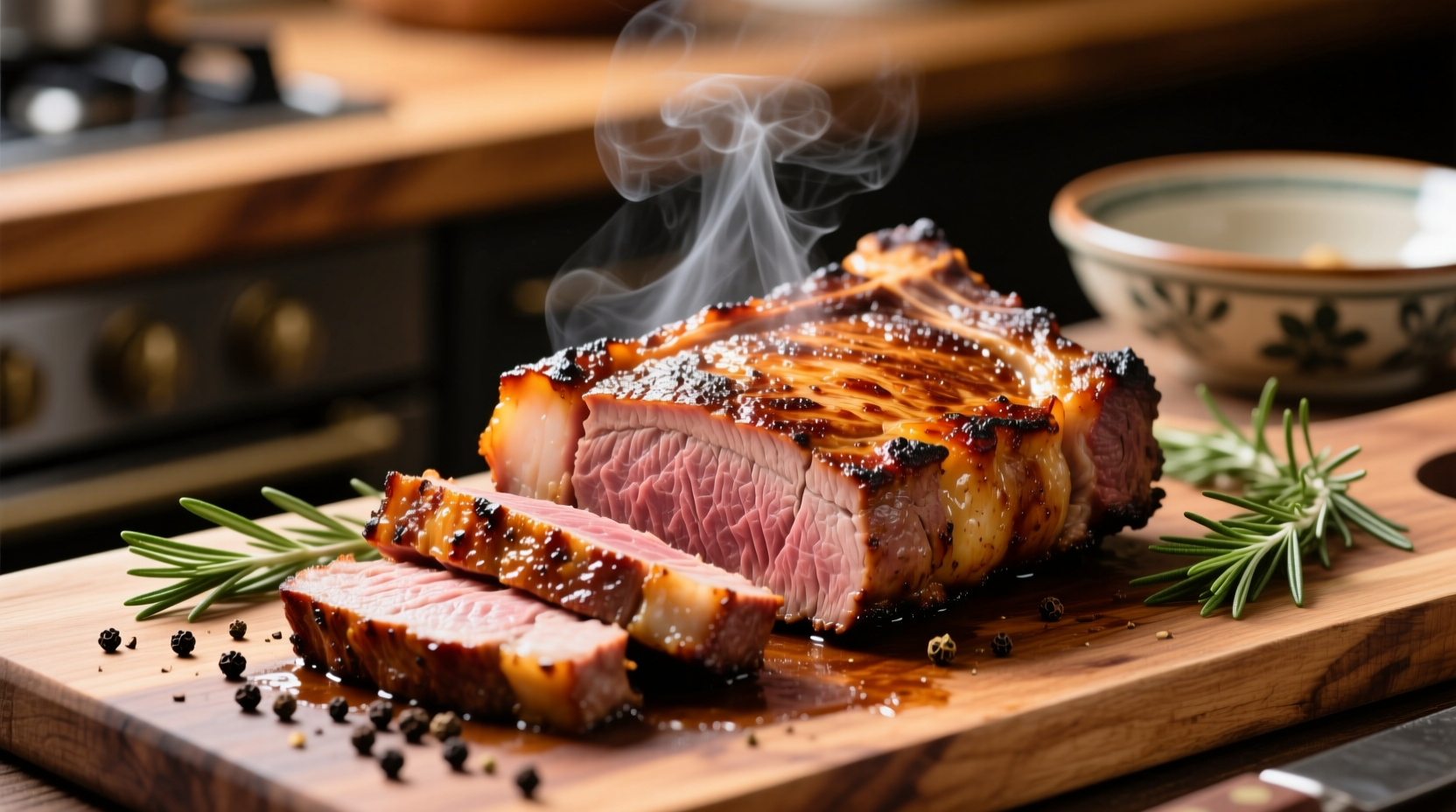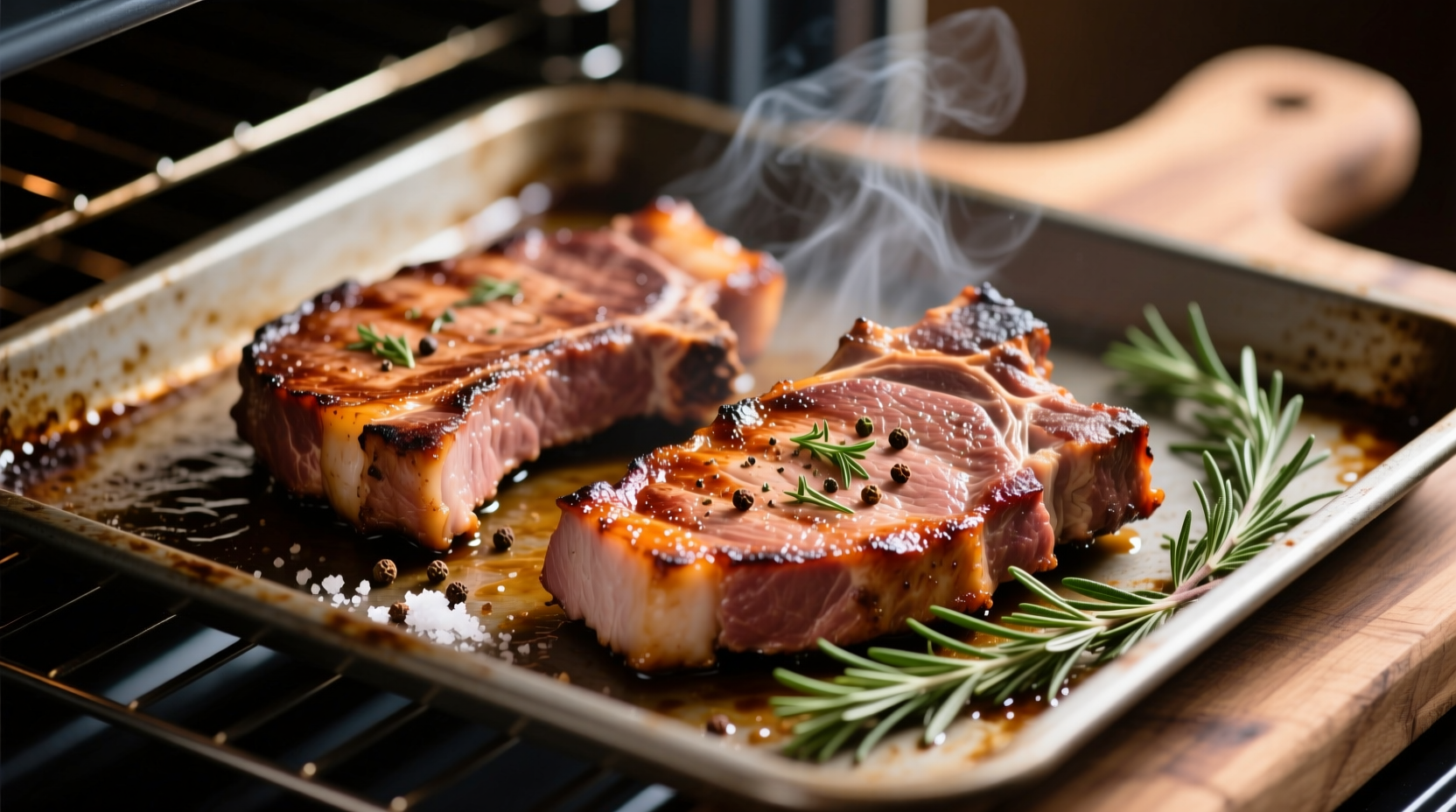Nothing beats perfectly cooked pork steaks with a juicy interior and golden-brown crust. But getting that ideal result requires precise timing and temperature control. As a chef who's cooked thousands of pork steaks in professional kitchens and home ovens, I've refined a reliable method that works whether you're cooking 1-inch thick center-cut pork steaks or thinner blade cuts.
Why Pork Steak Thickness Determines Cooking Time
Unlike many foods, pork steak cooking time isn't measured solely in minutes—it's directly tied to thickness. A 1-inch steak needs significantly less time than a 1.5-inch cut. This relationship follows basic food science principles: heat penetrates meat at a relatively consistent rate, so thicker cuts require proportionally more time to reach safe internal temperatures.
| Pork Steak Thickness | Oven Temperature | Approximate Cooking Time | Target Internal Temp |
|---|---|---|---|
| 3/4 inch (2 cm) | 375°F (190°C) | 12-15 minutes | 145°F (63°C) |
| 1 inch (2.5 cm) | 375°F (190°C) | 15-18 minutes | 145°F (63°C) |
| 1.25 inches (3.2 cm) | 375°F (190°C) | 18-22 minutes | 145°F (63°C) |
| 1.5 inches (3.8 cm) | 375°F (190°C) | 22-25 minutes | 145°F (63°C) |
This cooking time chart reflects data from the USDA Food Safety and Inspection Service, which confirms that pork is safe to eat at 145°F with a 3-minute rest period. The chart accounts for standard home oven conditions and assumes pork steaks start at refrigerator temperature (40°F or below).
Essential Preparation Steps for Perfect Results
Before your pork steaks even enter the oven, proper preparation makes all the difference:
- Dry the surface thoroughly with paper towels—moisture prevents proper browning
- Season generously with salt at least 45 minutes before cooking to enhance flavor penetration
- Bring to cool room temperature for 20-30 minutes before baking for more even cooking
- Preheat your oven completely—never put pork in a warming oven
- Use an oven-safe rack on a baking sheet for proper air circulation

How to Monitor Cooking Progress Accurately
Setting a timer provides a starting point, but the only reliable method to determine doneness is with an instant-read thermometer. Digital thermometers have transformed home cooking accuracy since their widespread adoption in the 2010s. Unlike older analog models, today's digital probes provide readings in seconds with 0.5°F accuracy.
Insert your thermometer into the thickest part of the steak, avoiding bone or fat pockets. Remove pork steaks from the oven when they reach 140°F—the temperature will continue rising 5 degrees during resting (carryover cooking). This precise monitoring prevents both undercooked and dried-out results.
Context Boundaries: When Standard Times Don't Apply
These cooking guidelines assume standard home oven conditions. Several factors can significantly alter cooking times:
- Convection ovens typically cook 25% faster—reduce time by 5-7 minutes
- Frozen pork steaks require 50% more time and yield less consistent results
- Cast iron cooking creates more surface browning but similar internal cooking times
- Marinated steaks with acidic components may cook slightly faster
- Oven hot spots can cause uneven cooking—rotate pans halfway through
For best results with thicker cuts (over 1.5 inches), consider the reverse sear method: cook at 275°F until 125°F internally, then sear in a hot skillet for perfect crust development without overcooking.
Resting: The Critical Final Step
Never skip the resting period! When you remove pork steaks from the oven, juices retreat from the heat toward the center. Cutting immediately releases these precious juices onto your cutting board. Follow this resting guide:
- 1-inch steaks: 5 minutes minimum
- 1.25-1.5 inch steaks: 7-10 minutes
- Cover loosely with foil to retain warmth without steaming
- Place on a warm plate or cutting board
During this period, carryover cooking completes the process, and juices redistribute throughout the meat. The USDA confirms that the 3-minute minimum rest period is essential for food safety, allowing residual heat to eliminate potential pathogens.
Troubleshooting Common Issues
Dry pork steaks: Usually caused by overcooking or skipping the rest period. Always remove at 140°F and rest properly.
Pale appearance: Indicates insufficient surface browning. Pat steaks drier before cooking and ensure your oven has fully preheated.
Uneven cooking: Results from inconsistent thickness. Consider butterflying thicker sections or using a sous vide pre-cook for precision.
Excessive smoke: Fat dripping onto oven elements. Use a baking sheet with raised edges or line with parchment paper.
Pro Tips for Restaurant-Quality Results
Professional kitchens achieve consistent results through these techniques you can replicate at home:
- Season with smoked paprika and garlic powder for depth without overpowering
- Add fresh rosemary or thyme sprigs to the baking sheet for aromatic infusion
- Finish with a pat of herb butter for luxurious mouthfeel
- Use the baking sheet drippings to create a quick pan sauce
- Cook bacon-wrapped pork steaks at 400°F for 18-22 minutes
Remember that modern pork is significantly leaner than varieties from 20 years ago, requiring more careful temperature monitoring to prevent dryness. Today's industry standards produce pork that's safe at 145°F, a shift from the 160°F recommendation of the early 2000s when pork was fattier and food safety standards differed.
Storing and Reheating Leftovers
Store cooked pork steaks in airtight containers within 2 hours of cooking. They'll keep for 3-4 days in the refrigerator. For best reheating results:
- Low-temperature oven method: 275°F until internal temp reaches 130°F
- Air fryer: 325°F for 4-6 minutes with light oil spray
- Never microwave, which makes pork rubbery and unevenly heated











 浙公网安备
33010002000092号
浙公网安备
33010002000092号 浙B2-20120091-4
浙B2-20120091-4